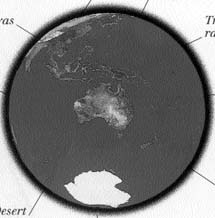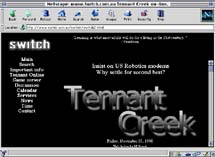Surfin' the stratosphere
Bear Logue and Michael Strand are the wetware behind
Tennant Creek's local internet service provider. They emerged from the
bunker long enough to try to explain how it all works
Basically, the Internet is a whole bunch of private networks
like ours all linked together and using common standards so that they
can talk to each other. Every computer has an IP address which might
be 203.39.10.195 and that identifies one of our computers here so that
any other computer in the world can put in an address like that and
it will turn up here because it's unique.
So when another computer in the world wants to talk to yours, by what route does the signal travel?
It can take any number of routers, in fact if you are
down loading a program for instance, it may actually be broken up over
ten different routers, it won't all come down the same path.
Basically the routers used on the Internet talk to each other and they're
always saying, "Hello, are you there?" and they make a map
of their little part of the network. So if they discover that if a particular
part of the network had gone down for some reason, they'll automatically
go via another part. A router might say, "I want to go there,"
and another one says, "no can't do it," but the next one says,
"yep I can take that," and so it gets there.
With your service, if somebody wants to put themselves
up a Homepage, what do you offer them?
We offer them 10 Megabytes of space and pretty much any
help they need to do it.
We have to assign the space for them and give them a password to get
into that space that's all.
When someone dials in to swtch.com and logs their computer,
dials the local number here and then it comes here, where does it go
then and how does it get to wherever it's going?
There are no modems here. A modem is a digital to analogue
converter so when your computer talks to your modem it starts off as
digital, the modem converts that to analog so it can travel along the
phone line (if you listen to it when you pick up a modem, it's squawking
and carrying on) that's analog. That goes into the exchange which converts
it into digital again.
What we've done is to run optical fibre from the exchange to here into
our equipment so that we don't convert back to analog to come to us.
It stays digital from the exchange all the way to us. What we've really
done by that is cut out a second stage of noise that could be introduced
to avoid poor quality lines and all that sort of business.
The only possible area where it can really be affected is that line
between your house and the exchange, not between us and the exchange,
it's as best as it can possibly be. The signal then comes in to our
equipment which is a Total Control US Robotics Remote Access Server.
It comes into there in digital and that basically routes it straight
through the system onto our network and keeps it digital all the way.
What's your out going signal, what happens after it
goes through the US robotics machine?
Basically you ring up, the service authenticates that
you are who you say you are. It comes back to you and says yep, it comes
down and you are now connected to our server.
You then bring your browser up and then you start making requests and
then your first request is going to be automated to swtch.com and that
all comes directly from our server and that will be our page which will
be "Tennant Creek" or whatever it is. Then when you make a
request out on ours, what it does is it actually sends a request out
into our DNS looking for whatever you're looking for, as it sends it
out through out router, before it goes through there it goes through
a proxy server and on that it says yes you're going out this way but
I want this packet to come back to this address.
What it does is it goes out on the landline looking for the actual sight
that you're trying to hit. Also inside that packet it's got a little
address in there that says please come back via the satellite and that
is to come back via San Francisco, Subic Bay then Tennant Creek and
we don't come back through all the other garbled crap through Telstra.
So it's doing thousands of little things before it even gets out onto
our router.
So are you sending out via satellite or are you just
getting back?
Just back. It's an ICN line back to the exchange, ICN
is digital. Basically, that ICN line goes from here to the exchange
and out north. It goes on Telstra lines to connect to the Internet gateway
in Darwin.
This is where it gets back to the bandwidth issue in that we went with
the satellite path because Telstra is the main Internet provider in
Australia, all Internet service providers get their bandwidth off Telstra.
What you've got in Darwin is a 4 Megabyte data link to the Telstra gateway
in Sydney. So you've got every Internet service provider in Darwin hooked
into this 4 mega bite link, that's a dedicated line just for the Internet.
But you've got all these big service providers up in Darwin like Aussie
Mail, Big Pond, Oct 4, there's a whole bunch of them. But they all have
2 Megabyte links into that 4 Megabyte link and when you add it up, it
doesn't work and so you've got too many people trying to pull too much
through too small a pipe into Darwin, which is generally why surfing
in the Northern Territory is not real quick.
What we'll do to avoid that is when a request goes out on our system,
the way our gear is set up is that it actually forges like an IP packet
when it's sent out as a request, has a return address in it which normally
would send it back via Telstra's system back down the landline.
Our equipment rips that address out and puts in a different return address
and that return address then makes the packet come back via the satellite
link. So it will go out with a false address basically and it will go
into the other site where the web site is you want the information from,
that web site will then take that packet, look at the address and send
the information to the address that's in the packet, which is not back
to Telstra, it's back to Subic Bay which is where the ground station
is for the satellite company.
What are your predictions for next century in terms
of the integration of some of the different technologies like cable,
TV, pay TV, Internet - do you think they'll come together?
I think they will eventually, when though, will be a good
question. They're actually trialing Internet 2 at the moment and basically
the Internet that everybody is using at the moment is based on fairly
old protocols that were started back with the US military hooking all
their nuclear silos and all that sort of thing together.
It grew from there so your talking 60's protocol that has been modified
slightly but not much. So a lot of the technology running it is all
very modern but a lot of the protocols are quite old and not capable
of doing what a lot of people want to do these days. So what they've
done now is started to hook up all the Universities and some government
and scientific bodies and that sort of thing and build a new Internet
which runs on totally new protocols.
At the moment nobody else is allowed onto it, it's only educational
and scientific research type bodies that are allowed to use the Internet
2 and basically at some point when it's grown enough that it can handle
it, they'll start cutting over the old Internet onto the new Internet,
all the predictions that people make will be able to actually start
happening.
They're talking protocols that are much more efficient at getting the
data from one end to the other, so it's a lot faster. Also, they are
protocols that are able to recognise priorities because at the moment
there are no priorities on the Internet, a packet is a packet, it's
all treated the same. But with Internet 2, certain packets will be given
priority over certain other packets, a packet carrying an email message
will be given a lower priority than a packet carrying a video.
So streaming video will actually come in reliably and actually stream,
not splutter in, whereas your email message might get held up a little
bit for the video message to get through. That's really where it's headed,
but who knows how far away that is at the rate things are going.
We're just more interested in the Tennant Creek area and we just wanted
everyone to have faster access and other added things which we're working
on.
We support the latest in V90 so if you've got a really good modem, you'll
notice the increase in speed. The equipment they're dialling into is
US Robotics and what happens with manufacturers that make equipment
for our end like an ISP's end and the modems, they add a little bit
extra in the protocols.
So a US Robotics modem will be V90 but when it talks to a US robotics
total control access server, it's got better standards that it can use.
The V90 standard is a little bit of a compromise between a whole bunch
of companies that were fighting about standards. So what US robotics
does is they make it so that it will talk at V90 compliancy but it will
actually run a bit quicker if you talk into the right gear, gear that
understands what you're talking about. There's only a couple of people
around town that have got US Robotics modems that we know of.
We don't sell US Robotic modems on a wholesale thing but if you ask
and request for one then we'd buy them. We can get one for you and it
costs $250, that's pretty normal for a modem really. You can get cheaper
modems but then you get what you pay for too. $250 is just for a standard
US Robotics system, it doesn't come with voice, fax and data things,
that's all added software. It's something that we;'ve been trying to
push, I think you only have to look at our web page to see that, that
US Robotics modems is the best way to hook into us, but it doesn't seem
like a lot of people are listening.



